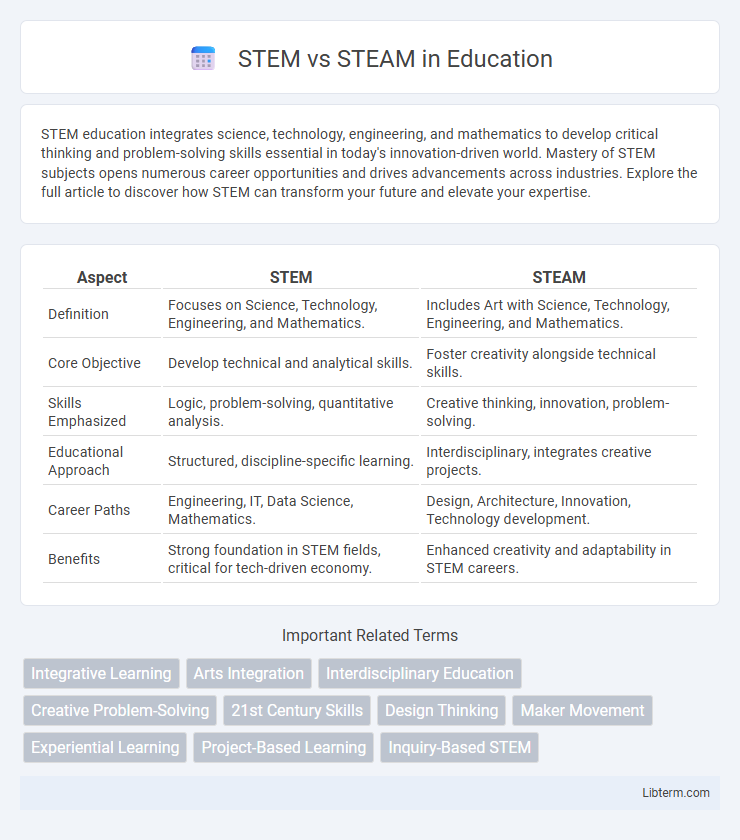STEM education integrates science, technology, engineering, and mathematics to develop critical thinking and problem-solving skills essential in today's innovation-driven world. Mastery of STEM subjects opens numerous career opportunities and drives advancements across industries. Explore the full article to discover how STEM can transform your future and elevate your expertise.
Table of Comparison
| Aspect | STEM | STEAM |
|---|---|---|
| Definition | Focuses on Science, Technology, Engineering, and Mathematics. | Includes Art with Science, Technology, Engineering, and Mathematics. |
| Core Objective | Develop technical and analytical skills. | Foster creativity alongside technical skills. |
| Skills Emphasized | Logic, problem-solving, quantitative analysis. | Creative thinking, innovation, problem-solving. |
| Educational Approach | Structured, discipline-specific learning. | Interdisciplinary, integrates creative projects. |
| Career Paths | Engineering, IT, Data Science, Mathematics. | Design, Architecture, Innovation, Technology development. |
| Benefits | Strong foundation in STEM fields, critical for tech-driven economy. | Enhanced creativity and adaptability in STEM careers. |
Understanding STEM: Core Principles
STEM education emphasizes Science, Technology, Engineering, and Mathematics as interconnected disciplines fostering critical thinking, problem-solving, and innovation. Core principles include hands-on learning, analytical reasoning, and applying theoretical knowledge to real-world challenges. Integrating these fields prepares students for careers in rapidly evolving technological landscapes by building foundational skills and conceptual understanding.
What STEAM Adds: The Role of Arts
STEAM education integrates the Arts into traditional STEM disciplines, enhancing creativity, critical thinking, and innovation. By incorporating visual arts, music, and design, STEAM fosters holistic problem-solving skills and encourages interdisciplinary learning. This approach prepares students for diverse careers by developing both technical expertise and creative expression.
Key Differences Between STEM and STEAM
STEM emphasizes science, technology, engineering, and mathematics, focusing on technical skills and analytical thinking, while STEAM incorporates the arts to foster creativity and innovation alongside these disciplines. The integration of arts in STEAM encourages critical thinking and problem-solving through creative expression, promoting a more holistic educational approach. This key difference highlights STEAM's broader scope, preparing students for diverse challenges by combining technical knowledge with artistic insight.
Historical Evolution: From STEM to STEAM
STEM education, emphasizing Science, Technology, Engineering, and Mathematics, emerged in the 1990s to address the growing demand for technical skills in a technology-driven economy. The transition to STEAM incorporated the Arts to foster creativity, innovation, and holistic problem-solving, recognizing that artistic skills enhance scientific and technical literacy. This evolution reflects educational policies and workforce trends that value interdisciplinary approaches for preparing students in the 21st-century economy.
Benefits of STEM Education
STEM education enhances critical thinking, problem-solving skills, and technological literacy essential for the modern workforce. Emphasizing science, technology, engineering, and mathematics, STEM prepares students for high-demand careers in innovation-driven industries. Research shows students engaged in STEM programs demonstrate higher academic achievement and increased motivation for pursuing advanced technical fields.
Advantages of Integrating Arts in STEAM
Integrating arts into STEM education enhances creativity, critical thinking, and problem-solving skills by encouraging students to approach technical challenges from innovative perspectives. The STEAM approach fosters improved communication and collaboration by incorporating design, visual expression, and storytelling, which are crucial for translating complex scientific concepts to diverse audiences. This interdisciplinary method also promotes engagement and motivation, helping students develop well-rounded skills that align with future workforce demands in technology, engineering, and the creative industries.
Real-World Applications: STEM vs STEAM Careers
STEM careers, encompassing science, technology, engineering, and math, primarily drive innovation in technical fields like software development, biomedical engineering, and data analysis. STEAM integrates the arts into STEM, fostering creativity and critical thinking essential for careers in design engineering, digital media, and product development where aesthetic and functional aspects intersect. Both career paths offer strong real-world applications, with STEAM enhancing problem-solving skills through interdisciplinary approaches that blend technical expertise with artistic insight.
Challenges in Implementing STEM and STEAM
Implementing STEM and STEAM programs faces challenges such as limited funding, insufficient teacher training, and curriculum integration difficulties. Schools often struggle with balancing rigorous science, technology, engineering, and math instruction while incorporating arts for STEAM, leading to resource allocation issues. Resistance to change and a lack of standardized assessment tools further complicate effective adoption and sustainability.
Future Trends in Education: STEM and STEAM
Future trends in education emphasize integrating STEM (Science, Technology, Engineering, and Mathematics) with the Arts to form STEAM, fostering creativity alongside technical skills. STEAM education promotes interdisciplinary learning, enhancing problem-solving abilities and innovation essential for emerging industries like AI, robotics, and renewable energy. Educational institutions increasingly adopt STEAM curricula to prepare students for complex real-world challenges, driving workforce readiness in a rapidly evolving technological landscape.
Choosing the Right Approach: STEM or STEAM?
Choosing between STEM and STEAM education depends on the goal of fostering either technical proficiency or creative innovation. STEM emphasizes science, technology, engineering, and math to develop analytical skills and problem-solving abilities, while STEAM integrates the arts to enhance creativity, critical thinking, and interdisciplinary learning. Educators and institutions should assess student needs and future career demands to determine whether a purely STEM focus or a STEAM approach better supports holistic development and adaptability in a rapidly evolving job market.
STEM Infographic

 libterm.com
libterm.com